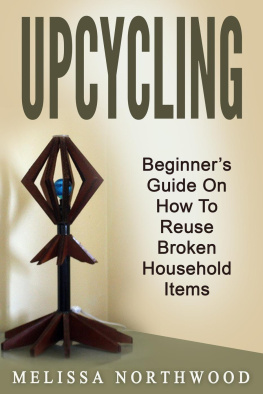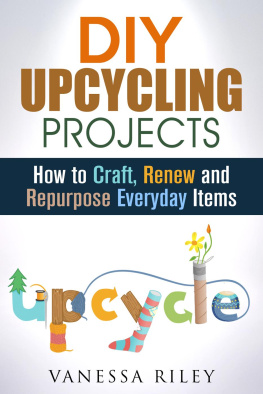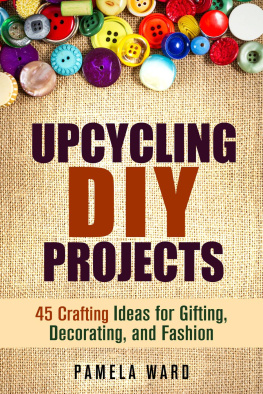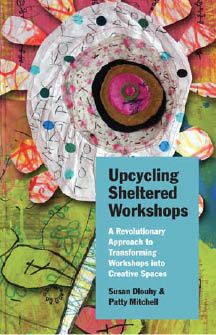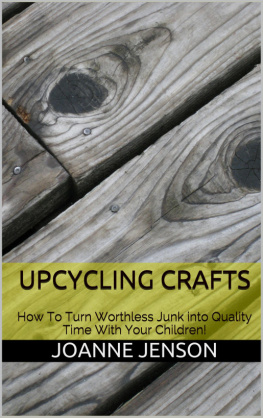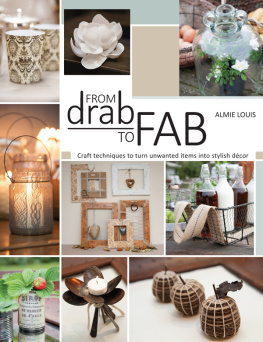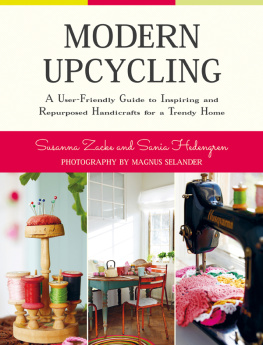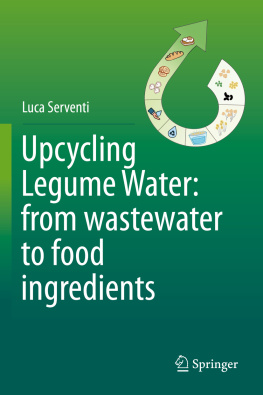While every precaution has been taken in the preparation of this book, the publisher assumes no responsibility for errors or omissions, or for damages resulting from the use of the information contained herein.
UPCYCLING: BEGINNERS GUIDE ON HOW TO REUSE BROKEN HOUSEHOLD ITEMS
First edition. March 14, 2017.
Copyright 2017 Marissa Northwood.
Written by Marissa Northwood.
10 9 8 7 6 5 4 3 2 1
Upcycling Guide (Reusing Glass Jars, Wine Bottles etc.)
Table of Contents
Introduction
M any of you might want to do your part in protecting our environment. One of the many ways you can do this is by reducing our garbage. While recycling might seem like the best option, there is an even better one: Upcycling. Upcycling is a step beyond recycling.
While recycling might be the common approach, why not take it one step further and ensure that no garbage ever reaches the dumpsite. Recycling prolongs the lifetime of items but upcycling ensures that they never end up in the trash.
In this book you will learn all about upcycling. You will learn about the principles and thoughts behind as well as how to upcycle some of the items you might commonly find in your own house.
Thank you for choosing this book. I hope it helps you contribute your bit towards our environment.
Chapter 1: What is Upcycling?
U pcycling is a process where you can convert your old and unwanted items into useful ones. IT is the process where you can transform your unwanted products into products that have a much better quality or have an environmental use. Upcycling often allows you to assign a better purpose to your items. It not only enables items to be useful, but it also enables them to look beautiful in the process. Sometimes the item will have a much better purpose once it has been upcycled than it had before. Upcycling is often referred to as creative reuse due to the fact that most items are upcycled in beautiful and creative ways.
Upcycling is not a new concept. While the terminology might be new, the concept of upcycling has been around for decades. In the 1940s, families used to upcycle everything they owned from sacks to doors. In recent times, upcycling has become a trend. Some people indulge in upcycling because of this while others enjoy the aesthetics of creating something beautiful from something that is old and worn out. However, one of the biggest inspirations behind upcycling is the impact it has on the environment. Upcycling is a way of life in a number of underdeveloped and developing countries where they have no access to raw materials. Hence, they make bottles, bowls, containers and clothes out of any material that they can find.
Upcycling is a simple concept but makes a powerful impact on the environment. The amount of garbage we can reduce by upcycling is enough to make an enormous impact in protecting the environment. The best part about upcycling is that you can upcycle just about anything.
Upcycling is a true cycle that aims at a balanced process to help save the environment. All industries should be attempting to achieve a complete upcycling form of production. For current standards, even an aim would be good enough. There could be ways to modify our products if the final aim is for them not to end up in a garbage dump.
Recycling vs. Upcycling
R ecycling and upcycling are often used interchangeably by people. However, it is essential for you to know that these two are not the same thing. We all know what recycling is. We might even be used to recycling a number of items that we use. However, that doesnt mean that you are upcycling items.
Recycling is the process that takes paper, plastic, glass and metal and breaks it down into its raw materials. These raw materials are then used to make new products. However, these products usually have a lesser quality than the original item. On the other hand, upcycling involves converting an existing item into a useful one without breaking it down into its raw material. It is made of the same material as the parent item and it has the same if not better quality as the original item. Upcycling only involves your creativity while recycling involves a lengthy process of reducing the item down to its components and then building a new one. For example, when plastic bottles are recycled they cannot be used again as bottles or other containers because of the risk of the plastic leaking into the edible items. Due to this, they eventually end up in other places such as toys or carpets that eventually end up as trash. Recycling essentially just prolongs the usage of an item but doesnt necessarily prevent it from becoming trash. If you truly want to prevent trash, then upcycling is the method to use. It reduces the trash we produce and it also decreases the need for more raw materials to make the same goods again. If we are talking about plastic bottles, then this means less oil wells drilled for plastic. If it is metal then it means lesser mining because in the end there is no demand for new raw materials since the existing ones havent been thrown away yet. To end it all, it means that the energy consumed and used is also lesser.
A lot of people claim that they are upcycling by making wallets from tires. However, these are ways of recycling. Its amazing that they are able to recycle stuff. However, that just isnt upcycling. Recycling is often the first step in achieving an upcycling lifestyle. However, the two terms should not be confused. It becomes upcycling only when the new items made move up the supply chain instead of making it longer.
There are two ways in which you can be a part of the upcycling movement. One is when you purchase upcycled items from a store. The other is when you upcycle your items to make something beautiful and useful. In this book we shall focus on the latter. However, it is important to know that both these methods reward you with the fact that you are contributing to saving the environment in your own small scale way. After all, it is these small acts that reap big rewards.
Before we talk about how you can upcycle a number of items, lets have a look at a classic example of upcycling. The soda can is the perfect example of an upcycling product. By melting these cans down and remolding them you can make cans that are just as good as the original and actually use less than 10% of the energy used to make one from scratch.
Chapter 2: Steps to Upcycle some Common Household Items
I n this chapter we shall go through some items that can be upcycled and also include some ideas for how they can be upcycled. Remember that these are just some ideas. With a creative mind you will have never ending ideas on upcycling these items.
Glass Jars
L ets have a look at glass jars. Glass jars are often used in the kitchen as containers. However, here is a number of other creative ways in which you can use them.
Pencil Holder
A glass jar can easily be converted into a beautiful pencil holder. All you need is some glass paint; a paintbrush, tape and the glass jar itself. Here are the steps to transform your glass jar into a pencil holder:
- Before you start first decide where all you plan to place the tape strips. If possible find tape that is like double sided tape or ones used in designing. You should be able to make basic design using these tapes that means they should not be flat. You could also use stencils to create a pattern.
- Once you have decided on the design, its time to actually paste the tape on the glass jar. If you are using a stencil then decide your color patterns.
- Then start painting on the glass. First, paint over the clear areas.
- Move onto the designed areas next and paint around the tape.

